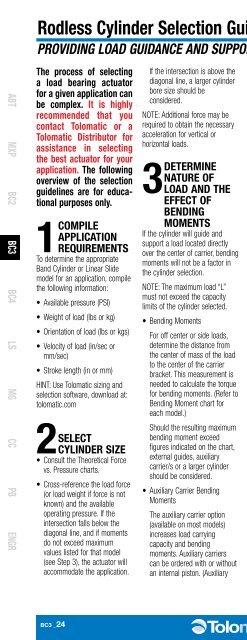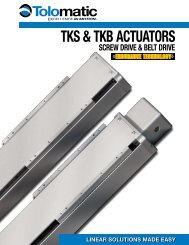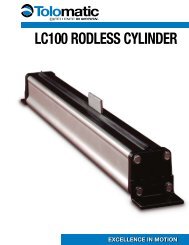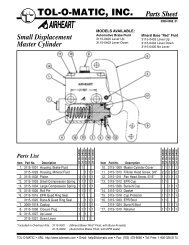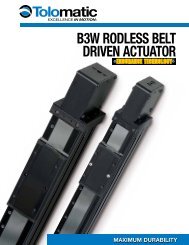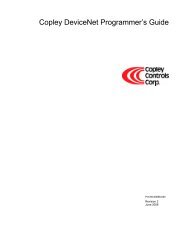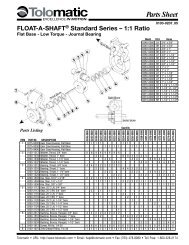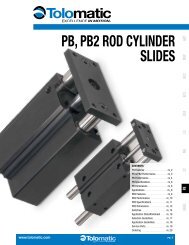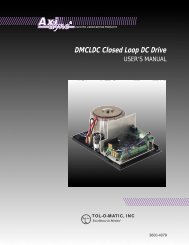BC3 ReCiRCulating Ball BeaRing Rodless CylindeR
BC3 ReCiRCulating Ball BeaRing Rodless CylindeR
BC3 ReCiRCulating Ball BeaRing Rodless CylindeR
Create successful ePaper yourself
Turn your PDF publications into a flip-book with our unique Google optimized e-Paper software.
<strong>Rodless</strong> Cylinder selection guidelines - BC2, <strong>BC3</strong>, BC4, ls - all sizes<br />
PROVIDING LOAD GUIDANCE AND SUPPORT<br />
abt MXP BC2 <strong>BC3</strong> BC4 LS MG CC PB ENGR<br />
the process of selecting<br />
a load bearing actuator<br />
for a given application can<br />
be complex. it is highly<br />
recommended that you<br />
contact tolomatic or a<br />
tolomatic distributor for<br />
assistance in selecting<br />
the best actuator for your<br />
application. the following<br />
overview of the selection<br />
guidelines are for educational<br />
purposes only.<br />
1CoMPile<br />
aPPliCation<br />
ReQuiReMents<br />
To determine the appropriate<br />
Band Cylinder or Linear Slide<br />
model for an application, compile<br />
the following information:<br />
• Available pressure (PSI)<br />
• Weight of load (lbs or kg)<br />
• Orientation of load (lbs or kgs)<br />
• Velocity of load (in/sec or<br />
mm/sec)<br />
• Stroke length (in or mm)<br />
HINT: Use Tolomatic sizing and<br />
selection software, download at:<br />
tolomatic.com<br />
2seleCt<br />
<strong>CylindeR</strong> siZe<br />
• Consult the Theoretical Force<br />
vs. Pressure charts.<br />
• Cross-reference the load force<br />
(or load weight if force is not<br />
known) and the available<br />
operating pressure. If the<br />
intersection falls below the<br />
diagonal line, and if moments<br />
do not exceed maximum<br />
values listed for that model<br />
(see Step 3), the actuator will<br />
accommodate the application.<br />
If the intersection is above the<br />
diagonal line, a larger cylinder<br />
bore size should be<br />
considered.<br />
NOTE: Additional force may be<br />
required to obtain the necessary<br />
acceleration for vertical or<br />
horizontal loads.<br />
3deteRMine<br />
natuRe oF<br />
load and the<br />
eFFeCt oF<br />
Bending<br />
MoMents<br />
If the cylinder will guide and<br />
support a load located directly<br />
over the center of carrier, bending<br />
moments will not be a factor in<br />
the cylinder selection.<br />
NOTE: The maximum load “L”<br />
must not exceed the capacity<br />
limits of the cylinder selected.<br />
• Bending Moments<br />
For off center or side loads,<br />
determine the distance from<br />
the center of mass of the load<br />
to the center of the carrier<br />
bracket. This measurement is<br />
needed to calculate the torque<br />
for bending moments. (Refer to<br />
Bend ing Moment chart for<br />
each model.)<br />
Should the resulting maximum<br />
bending moment exceed<br />
figures indicated on the chart,<br />
external guides, auxiliary<br />
carrier/s or a larger cylinder<br />
should be considered.<br />
• Auxiliary Carrier Bending<br />
Moments<br />
The auxiliary carrier option<br />
(available on most models)<br />
increases load carrying<br />
capacity and bending<br />
moments. Auxiliary carriers<br />
can be ordered with or without<br />
an internal piston. (Auxiliary<br />
carriers without a piston have<br />
no internal cushion on the<br />
cylinder end closest to the<br />
auxiliary carrier.)<br />
IMPORTANT: When ordering,<br />
determine the working stroke,<br />
then the minimum distance<br />
required between carriers<br />
(dimension “D” in Auxiliary<br />
Carrier Bending Mom ents<br />
chart). When ordered,<br />
Tolomatic’s configurator will<br />
calculate the overall length of<br />
the actuator.<br />
NOTE: breakaway pressure will<br />
increase when using auxiliary<br />
carriers.<br />
4deteRMine<br />
inteRnal<br />
Cushion<br />
CaPaCity<br />
• Consult the Cushion Data chart<br />
for the model selected. The<br />
velocities listed on the cushion<br />
charts are final or cushion<br />
impact velocities. On<br />
applications where the internal<br />
cushions or bumpers are to be<br />
used, be sure the actual, final<br />
or impact velocity is known. If<br />
the velocity is not known, use<br />
of limit switches with valve<br />
deceleration circuits or shock<br />
absorbers should be<br />
considered. NOTE: The BC205<br />
uses external bumpers in place<br />
of internal cushions, LS05 &<br />
LS10 do not have cushions or<br />
bumpers.<br />
• Cross-reference the final<br />
velocity and weight of the load.<br />
If the intersection is below the<br />
diagonal lines, the internal<br />
cushions on the actuator may<br />
be used. If the point falls above<br />
the dashed diagonal line or if<br />
the velocity is not known, use<br />
deceleration circuits, external<br />
shock absorbers or select a<br />
larger cylinder with greater<br />
cushion capacity. On highcyclic<br />
applications, use of<br />
external stops is strongly<br />
recommended.<br />
5deteRMine<br />
tuBe suPPoRt<br />
ReQuiReMents<br />
• Consult the Tube Support chart<br />
for the model selected.<br />
• Cross reference the load<br />
weight and maximum distance<br />
between supports.<br />
6ConsideR<br />
oPtions<br />
• Switches– dc Reed, Hall-effect<br />
or ac Triac<br />
Band Cylinders and Linear Slides<br />
each have different standard<br />
features and options. Check the<br />
options section for the actuator<br />
you have selected.<br />
• Shock Absorbers– if needed.<br />
• Foot Mounting Kits<br />
• Floating Mount Bracket – use<br />
when lack of parallelism<br />
occurs between the cylinder<br />
and an external guided and<br />
supported load.<br />
• Single End Porting (<strong>BC3</strong>, BC4)<br />
• Long Carrier (BC4)<br />
• Proximity Sensors (LS)<br />
• Dual 180° Carrier (<strong>BC3</strong>)<br />
<strong>BC3</strong> _24 1.800.328.2174


